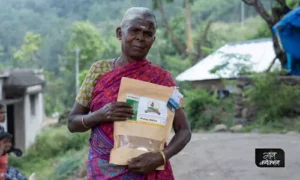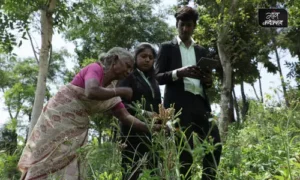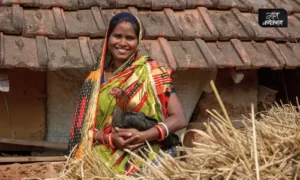Like millions of other farmers in Uttar Pradesh, 56-year-old Rajendra Prasad, from Varanasi’s Birbhanpur town had already sowed paddy by mid-June in anticipation of the arrival of the monsoon rains by June 20.
However, there was no sign of rain which wreaked havoc on Prasad’s paddy saplings. The farmer was entirely dependent on rainfall and could not afford to irrigate his paddy nursery spread over a bigha [quarter of an hectare] of land. Desperate, he undertook a second sowing of paddy, which too is barely surviving.
“Half of my crop has dried and perished. I had invested Rs 3,000 to sow my field. I had no option but to sow paddy again around mid-July when it began to rain. So far, I have spent almost Rs 4,500 on my paddy crop and it’s still in the initial stages of the paddy cultivation,” Prasad told Gaon Connection.
“A single bigha of paddy usually gets me a selling price of Rs 12,000 but my investment on the crop will easily exceed the input cost this year. I am fully aware that I am cultivating at a loss this time,” the farmer added despondently.
Over 300 kilometres from Prasad’s village, 40-year-old Durgavati, a paddy farmer from Barabanki’s Suratganj town said that she had invested all her savings on this year’s paddy crop which she sowed on three acres [almost 1.2 hectares] of land.

Agriculture experts are warning of a drop in paddy production this year. Photo by Yash Sachdev
“I have never seen this kind of weather before. The entire saawan (rainy season) is about to end and there has been negligible rainfall. My paddy seedlings are on the verge of drying up. They have already begun getting yellowish,” she said, and added that her sowing costs have gone up manifold.
Uttar Pradesh (UP) is the second highest paddy producing state in India. Deficient monsoon rainfall in this year has badly affected millions of farmers in the state who cultivate kharif paddy.
As part of our new series – Paddy Pain – Gaon Connection reporters travelled across the key paddy producing states to document the impact of deficient monsoon rainfall on the paddy crop this year. And the reports they have come back with seem worrisome, as paddy farmers are reportedly staring at huge crop losses. And these local crop losses have a global impact as a drop in rice production in the country is likely to disrupt global food supply, as India is the world’s top exporter of rice.
This story from Uttar Pradesh is the first in the ‘Paddy Pain’ series. Apart from Uttar Pradesh, the other chief paddy growing states in the Indo-Gangetic belt of the country – Bihar and Jharkhand – and also West Bengal, which produces the highest paddy in the country, have also received low monsoon rainfall that has affected paddy sowing and reduced the acreage under paddy cultivation.
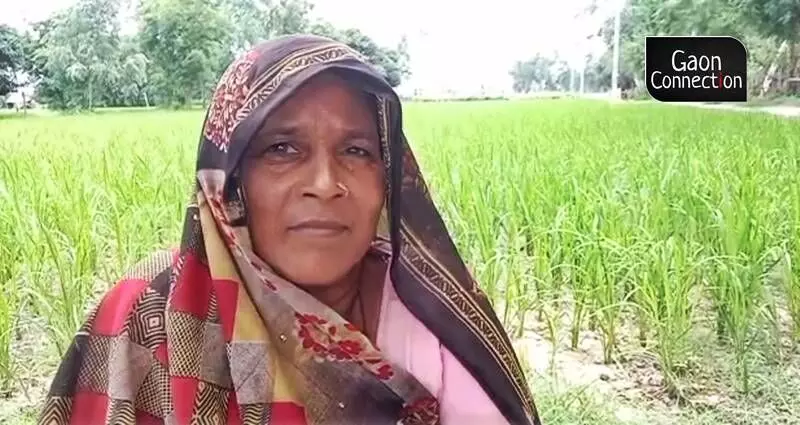
Durgavati, a paddy farmer from Barabanki’s Suratganj. Photo by Virendra Singh
Agriculture experts are warning of a drop in paddy production this year. “The late sowing of paddy along with inadequate rainfall will naturally have some effect on the paddy production this year,” Rajesh Gupta, Director of Statistics and Farm Insurance wing of the agriculture department in UP, informed Gaon Connection. Wheat production had already taken a hit this year due to early heatwaves in March.
Also Read: Bonanza for Indian wheat exporters, but cuts in wheat quota under the PM Garib Kalyan Anna Yojana
“Not only will the late sowing affect the upcoming rabi [winter] crops as farmers will have far less time to prepare their fields, but insufficient rainfall will also hamper rice production,” Daya Shankar Srivastava, agriculture scientist at Sitapur’s krishi vigyan kendra [farm science centre] said. “If farmers prefer to cultivate oilseeds and pulses that require less water, then they can profit during harvest but there is not much hope from paddy this year,” the agriculture scientist added.
Deficient rainfall in top paddy producing states
Rice is the most important staple food of the country consumed by about 65 per cent of the population, as noted in a June 2021 paper, Growth Performance and Profitability of Rice Production in India: An Assertive Analysis. It is grown in almost all the states, however, the major rice producing states with respect to their share in total rice production of the country during 2018-19 are West Bengal (13.79 %), Uttar Pradesh (13.34 %), Andhra Pradesh including Telangana (12.84 %), Punjab (11.01 %), Odisha (6.28 %), Chhattisgarh (5.61 %), Tamil Nadu (5.54 %), Bihar (5.19 %), Assam (4.41 %), Haryana (3.88 %) and Madhya Pradesh (3.86 %).
A number of these top paddy producing states have received deficient rainfall this monsoon season (which extends from June to September), so far.
For instance, as per the India Meteorological Department (IMD), between June 1 and August 8, Uttar Pradesh had registered an overall rainfall deficit of minus 40 per cent, with districts like Farrukhabad, Amroha, Rampur, and Kushinagar reporting a deficit of more than 70 per cent.


Similarly, West Bengal and Bihar have received deficient rainfall of minus 35 per cent and minus 25 per cent in the same time period, respectively. Jharkhand, where a large number of farmers grow kharif paddy, has recorded a rainfall departure of minus 48 per cent. Odisha has an overall deficient rainfall of minus nine per cent.
Deficient rainfall has a direct impact on kharif sowing as rainfed agriculture occupies about 51 percent of the country’s net sown area and accounts for nearly 40 per cent of the total food production, as noted by the Ministry of Agriculture and Farmers’ Welfare.
Also Read: Fear of drought looms large over Bundelkhand; paddy and pulses crops affected
Savings spent on paddy sowing; farmers demand drought relief package
“The cost of sowing paddy with water provided from an engine [electricity- operated water pumps] in an acre of land is Rs 15,000 this year. When it rains normally every year, the cost is a thousand rupees per acre. If we don’t receive adequate rainfall soon, our crops will surely fail and will lose all our savings along with it,” Durgavati from Suratganj said.
About 200 kilometres from Durgavati’s agricultural field, 55-year-old Premchand Verma, a farmer from Lakhimpur Kheri’s Mitauli tehsil told Gaon Connection that he had little hopes for any earning from paddy this year.
“The biggest expense is on the tubewell. I had to use the tubewell pump to irrigate my field and it takes almost six hours to irrigate a bigha [quarter of an hectare]. It takes a litre of diesel to run the pump for an hour. Diesel costs almost hundred rupees a litre,” Verma said.
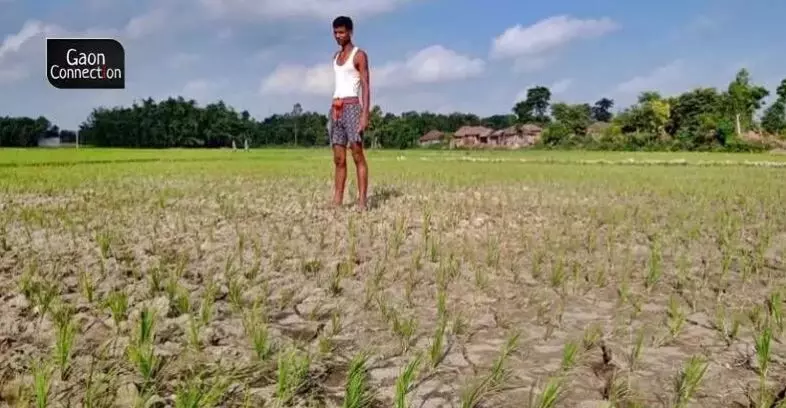
A number of these top paddy producing states have received deficient rainfall this monsoon season (which extends from June to September), so far. Photo by Rahul Kumar
Farrukhabad district in Uttar Pradesh has recorded the second highest rainfall deficit of minus 81 per cent so far (largest rainfall departure in Rampur district at minus 82 per cent). Rahul Gupta, a paddy farmer from Neevalpur village in Farrukhabad informed Gaon Connection that he lost his entire paddy crop in the first sowing and has now sowed paddy again in the hope of its survival.
“I have used water from a drain to irrigate my paddy but the drain brings water from a nearby factory and has chemical pollutants in it. I have no other option but to irrigate my crop,” he said.
Moonge Lal, the pradhan [village head] of Madhopur village in Farrukhabad district told Gaon Connection that almost every farmer in his village had recorded a complete loss of first sowing of paddy.
“The lack of rainfall has been disastrous to farmers. It hasn’t rained at all. The government should ideally declare a drought and provide a relief package to the farmers who are reeling under losses,” Lal told Gaon Connection.
‘It’s too late; there is little hope’, say agriculture experts
Rajesh Gupta, Director of Statistics and Farm Insurance wing of the agriculture department informed Gaon Connection that as of August 6, about 90.13 per cent of the targeted kharif paddy area in Uttar Pradesh has been sown with the crop.
There has also been a drop in area under paddy this kharif season in the country. Data released by the Union Ministry of Agriculture and Farmers Welfare last month on July 29 has revealed that the paddy sowing across the country is 13.28 per cent less as compared to the sowing last year.
“About 231.59 lakh ha [hectares] area coverage under rice has been reported compared to corresponding period of last year (267.05 lakh ha). Thus 35.46 lakh ha less area has been covered compared to last year,” the report on crop situation mentioned.
The agriculture ministry’s report informed that less sowing area is reported from the states of West Bengal, Uttar Pradesh, Bihar , Jharkhand, Telangana, Odisha, Chikattisgach, Tripura, Assam, Karnataka, Andhra Pradesh, Meghalaya, Haryana, Mizoram, Uttarakhand, J&K, and Sikkim.
VK Sharma, an agricultural scientist from the farm science centre in Farrukhabad (UP) said that their centre had advised farmers to plant fodder or oilseeds instead of paddy.
“It is too late for the paddy to be sown now. There is little hope of profits as the farmers have invested a lot on irrigation. Paddy productivity is also expected to be lower as the soil is gradually losing moisture now,” Sharma warned.
Agrarian distress, low rice production likely to affect food security
“Not just Uttar Pradesh but Bihar, West Bengal and Jharkhand are also reporting a rainfall deficit in the paddy sowing season. This is bound to affect rice production in the country,” Balram, a Jharkhand-based food activist from the Right to Food campaign told Gaon Connection.
“The wheat production was affected by early heatwaves and now insufficient rainfall on paddy is set to upset the balance. Two main staple crops being affected is likely to have an impact on the grain stocks in the country,” he added.
This could pose a threat to national food security and the food ration schemes launched by the governments to address poverty and impoverishment.
The free ration distribution scheme [Pradhan Mantri Garib Kalyan Yojana] was launched in April 2020 to help the poor sections of the society who are yet to recover from the economic devastation caused by the COVID-19 pandemic. Under this scheme, five kilogrammes of grains a month are distributed to individuals belonging to poor sections of the society on a monthly basis.
“This scheme was extended for six months in March this year and is set to expire in September — at a time when the threat of food crisis is hovering all over. The government should definitely extend the scheme as we are headed for a food crisis,” Balram said.
“Even when the monsoon rainfall is adequate, the three months of August-September-October are known to cause stress on food security in the country. Small farmers spend all their savings on kharif [summer] crops and starvation deaths are mostly reported in these months,” the activist pointed out.
Also Read: Nothing bullish about Jharkhand’s largest cattle fair as low rainfall and fear of drought hit sales
Global food crisis due to a drop in India’s rice production?
The ramifications of low production of paddy in India can potentially affect the global supply of rice as well. According to the United States Department of Agriculture, India is the largest exporter of rice in the world and contributes 40 per cent to the global supply.
As per a December 16, 2021 press release issued by Press Information Bureau, in 2020-21, India’s rice exports rose by a whopping 87 per cent to 17.72 million tonne (MT) from 9.49 MT achieved in 2019-20.
“In terms of value realisation, India’s rice exports rose by 38 per cent to USD [United States Dollar] 8815 million in 2020-21 from USD 6397 million reported in 2019-20. In terms of Rupees, India’s rice export grew by 44 per cent to Rs 65298 crore in 2020-21 from Rs 45379 crore in the previous year,” the press statement mentioned.
The looming crisis on rice exports in India is reminiscent of a similar situation six months ago when early heatwaves reduced the production of wheat which forced the Indian government to call off exports in order to meet the domestic demand.

The agriculture ministry’s report informed that less sowing area is reported from the states of West Bengal, Uttar Pradesh, Bihar , Jharkhand, Telangana, Odisha, Chikattisgach, Tripura, Assam, Karnataka, Andhra Pradesh, Meghalaya, Haryana, Mizoram, Uttarakhand, J&K, and Sikkim. Photo by Virendra Singh
The decision to suspend wheat exports was announced even when there was a spike in demand in the international markets due to supply chain disruptions as a consequence of the Ukraine-Russia war.
Why deficient rainfall in Indo-Gangetic plains?
The formation of low pressure areas in the Bay of Bengal and shifting of their locations were the primary reasons for rainfall deficit in some states in the Indo-Gangetic plains, say weather experts.
“The low pressure areas which developed one after another in the Bay of Bengal during June-July have developed towards the western part of the Bay rather than their usual locations along the north-western portions of the water body. This has resulted in the shifting of the monsoon trough towards central India rather than its normal location along the Indo-Gangetic plains,” Mahesh Palawat, vice president of meteorology and climate change at SkymetWeather — a private weather agency, told Gaon Connection.
“The rainfall in the Indo-Gangetic plains which began by July 19 will not be enough to compensate for the loss of precipitation in the months of June and the half of July,” Palawat said. “So, this year we are witnessing a rainfall deficit in the major rice producing states such as Uttar Pradesh, West Bengal, Jharkhand, and Bihar,” he added.
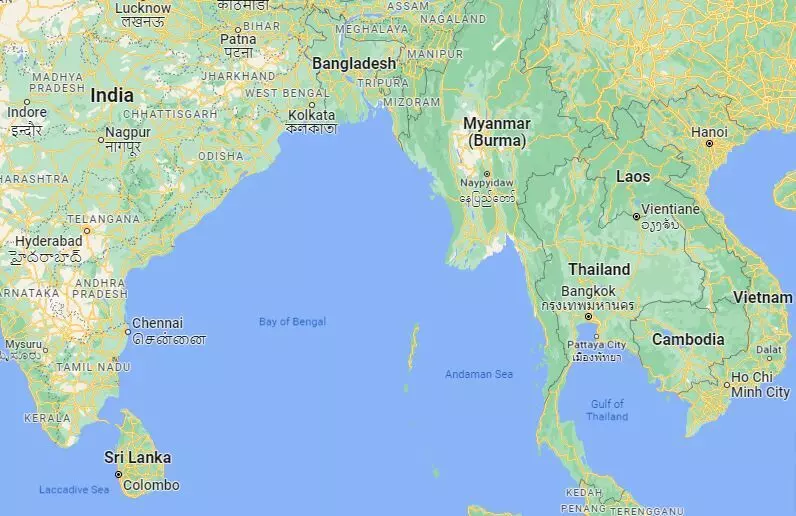
The formation of low pressure areas in the Bay of Bengal and shifting of their locations were the primary reasons for rainfall deficit in some states in the Indo-Gangetic plains, say weather experts. Photo: Google Maps
Also Read: Kashmir’s apple crop hit due to low rainfall and drought-like conditions
However, the weather expert pointed out that the central part of the country, which includes areas like the drought prone Marathwada and Vidarbha regions of Maharashtra, and other areas like Telangana’s northern regions as well as southern parts of Madhya Pradesh have witnessed satisfactory rainfall this year.
“It is too early to say whether climate change is having an impact but the ocean temperatures are definitely rising. If these low pressure areas continue to form towards the west and the Indo-Gangetic plains get deficit rainfall and the central Indian region witnesses good rainfall in the coming years as well, then we can surely say that the climate has changed,” Palawat added.
However, poor farmers like Durgavati in Barabanki have no understanding of the weather dynamics and the changing climate. All they know is that crop failure and low production will force them to incur debts and work as labourers for the rest of the year in order to sustain a livelihood.
Anchored and written by Pratyaksh Srivastava. With inputs from Ankit Singh in Varanasi, Ramji Mishra in Lakhimpur Kheri, and Virendra Singh in Barabanki.







